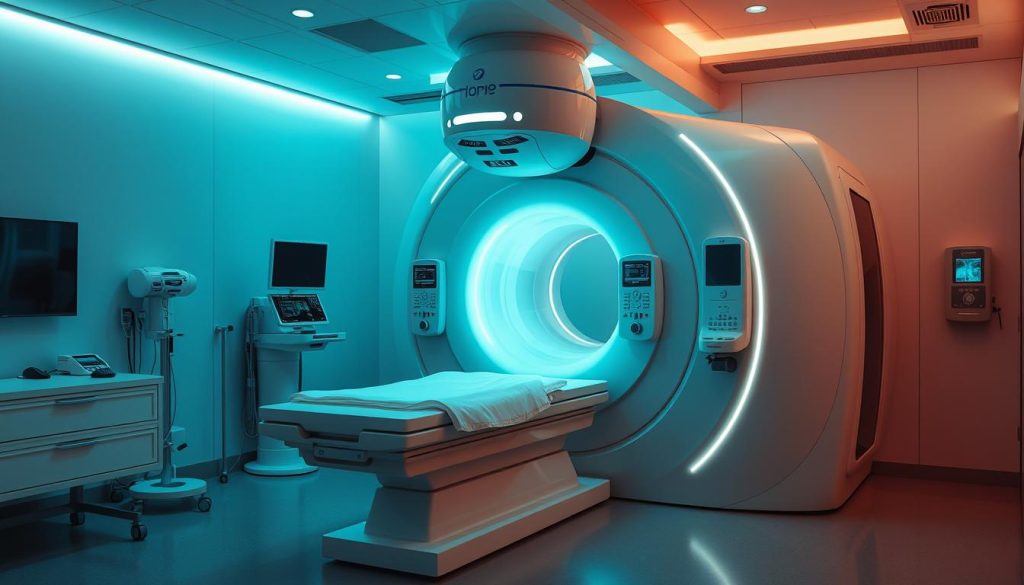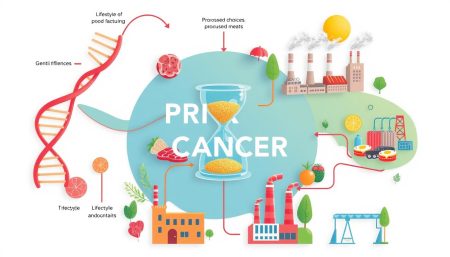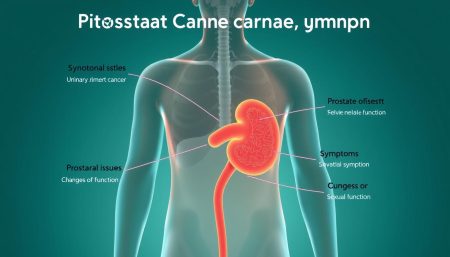When someone gets a bone marrow cancer diagnosis, they often wonder about life expectancy. This question is a big worry for patients, their families, and doctors. The prognosis for bone marrow cancer can change a lot, so there’s no single answer for everyone. We’re going to look at what affects survival chances and what people with this serious illness might face.
Facing bone marrow cancer can feel overwhelming, but new treatments and research offer hope. We’ll look at statistics, treatment options, and the human spirit’s strength. Our goal is to give support and insight into the prognosis and life expectancy for those with bone marrow cancer.
Key Takeaways
- Life expectancy with bone marrow cancer varies and is influenced by several key factors.
- Understanding the individual’s prognosis is critical for navigating treatment options.
- Advances in medicine have enhanced survival chances for many patients.
- Each patient’s journey with bone marrow cancer is unique, calling for personalized support.
- Information and stories shared in this article may provide hope and guidance.
Understanding Bone Marrow Cancer Diagnosis
Diagnosing bone marrow cancer is a crucial step in health care. It starts with knowing what it is and the signs that need medical attention. Early detection and recognizing symptoms can greatly improve treatment results.
What is Bone Marrow Cancer?
Bone marrow cancer affects the bone marrow, where blood cells are made. It’s a group of diseases where abnormal cells grow too much. This can harm blood production and the immune system.
Types of Bone Marrow Cancer
There are several cancer types that fall under bone marrow cancer. Each has its own traits and effects:
- Leukemia – causes an abnormal increase in white blood cells.
- Multiple Myeloma – involves cancerous plasma cells.
- Myelodysplastic Syndromes – affects blood cell production.
Common Symptoms to Watch For
Spotting the symptoms of bone marrow cancer is key for early treatment. Look out for:
- Unexplained fatigue and weakness
- Frequent infections
- Bruising or bleeding easily
- Bone pain and fractures
The table below lists signs that might mean you need a bone marrow cancer diagnosis.
| Sign/Symptom | Possible Implication |
|---|---|
| Persistent Fatigue | Indicates abnormal blood cell function |
| Excessive Bruising | Could signal platelet issues and abnormal clotting functions |
| Severe Bone Pain | Potential symptom of bone density loss or fracture from weakened bones |
| Weight Loss | Unexplained weight loss could be a sign of advanced disease |
Spotting these symptoms early is vital for diagnosing and treating bone marrow cancer. It helps doctors decide on the right tests and treatments.
Staging of Bone Marrow Cancer
Getting the right treatment for bone marrow cancer starts with knowing its stage. Doctors look at how the cancer has grown. This helps plan treatment and guess how well the patient will do.
Importance of Staging
Staging bone marrow cancer shows how far it has spread. It tells doctors how to treat it best. It also helps guess how well the patient will do.
Different Stages Explained
Each stage of bone marrow cancer shows how serious it is. This guides how doctors will treat it. Here’s what each stage means:
- Stage 1: Cancer is in one place, usually in the bone marrow.
- Stage 2: Cancer is more spread out but not everywhere. It might be in different parts of the same bone or nearby lymph nodes.
- Stage 3: Cancer has moved to other bones or distant lymph nodes.
- Stage 4: This is the worst stage. Cancer has spread a lot, even to important organs. This makes treatment harder and the outlook less good.
| Stage | Description | Typical Treatment Approach |
|---|---|---|
| Stage 1 | Limited to bone marrow | Localized treatments such as radiation or targeted therapy |
| Stage 2 | Local spread within bone structures | Combination of chemotherapy and localized treatments |
| Stage 3 | Radiologically observable spread to multiple sites | Systemic chemotherapy followed by targeted treatments |
| Stage 4 | Extensive spread, including to organs | Aggressive multifaceted treatment including new experimental options |
Knowing the stage of bone marrow cancer is key. It helps doctors choose the best treatment. It also helps patients and doctors know what to expect.
Treatment Options for Bone Marrow Cancer
Managing bone marrow cancer requires a treatment plan that fits each person’s needs. The main treatments are chemotherapy, radiation therapy, and stem cell transplants. These methods help fight the disease and improve the patient’s life through supportive care.
Chemotherapy and Its Effects
Chemotherapy is a key part of treating bone marrow cancer. It uses strong drugs to kill cancer cells. But, it can also harm healthy cells, causing side effects like nausea and fatigue.
These effects happen because chemotherapy targets both cancer and healthy cells. This means we need to manage these effects carefully and use supportive therapies.
Radiation Therapy
Radiation therapy uses high-energy rays to kill cancer cells. It focuses on areas where cancer is found, helping to reduce tumors and symptoms. New methods try to protect healthy cells, reducing side effects.
Stem Cell Transplantation
A stem cell transplant is crucial for patients with damaged bone marrow. It replaces the diseased marrow with healthy cells, which can come from the patient or a donor. Recovery is long and requires a clean environment to avoid infections.

| Treatment Type | Primary Function | Common Side Effects |
|---|---|---|
| Chemotherapy | Eliminate cancer cells | Nausea, Fatigue, Risk of Infection |
| Radiation Therapy | Shrink Tumors | Skin Irritation, Fatigue |
| Stem Cell Transplant | Replace diseased bone marrow | Infection Risk, Graft-versus-host disease |
It’s important to know about each treatment, their effects, and how to manage them. As medical science improves, so does the treatment for bone marrow cancer. This means better care and a better life for patients.
Factors Influencing Life Expectancy
When we talk about bone marrow cancer, many life expectancy factors are key. These factors are linked to a person’s health impact and how well they do with treatment response.
Age and General Health
A person’s age and health are big factors in fighting bone marrow cancer. Younger people with fewer health issues usually do better. They can handle tough treatments and recover faster.
Disease Type and Stage
The type and stage of bone marrow cancer are very important. They help decide the treatment plan. Early stages mean the cancer is easier to treat, which helps with life expectancy.
Response to Treatment
How well a patient responds to treatment is also crucial. A good response can greatly improve chances of survival. This shows why treatments need to be tailored to each person.
| Age Group | Typical Health Status | Expected Treatment Response |
|---|---|---|
| Young Adults | Good | Highly Responsive |
| Middle-Aged Adults | Moderate | Variable |
| Senior Adults | Fragile | Less Responsive |
In summary, understanding life expectancy with bone marrow cancer is complex. It involves looking at age, health, cancer type, and treatment response. Each factor gives a unique view of what might happen, showing how unique each patient’s journey is.
Statistics on Survival Rates
Looking into the statistical prognosis and bone marrow cancer survival rates gives us important insights. It helps both patients and doctors understand the disease better. These numbers are key to seeing how well someone might do in the short and long term. But, it’s important to remember that each person’s case is unique.
Overview of Survival Statistics
For years, survival rates for bone marrow cancer have been tracked. This data helps us understand how the disease usually progresses. The rates change a lot based on the type of cancer, when it’s found, the patient’s age, and their overall health.
Long-Term vs. Short-Term Survival Rates
Looking at both long-term and short-term survival rates shows us some key trends. These trends help doctors make decisions and help patients know what to expect. The rates for the first 5 years after diagnosis are different from those for longer periods.
| Duration | Survival Rate |
|---|---|
| 1 Year | 78% |
| 3 Years | 63% |
| 5 Years | 56% |
| 10 Years | 34% |
Lifestyle Changes to Consider
For those fighting bone marrow cancer, making lifestyle changes can greatly improve their life quality and health. Focusing on diet and nutrition, exercise benefits, and psychological health helps both physical and mental recovery.
Nutrition and Diet
Eating a balanced diet is key in cancer care. Foods rich in nutrients help the body deal with treatment side effects. Eating fruits, vegetables, lean proteins, and whole grains keeps strength and immune function up.

Importance of Exercise
Exercise is very beneficial for cancer patients. It reduces fatigue, stress, and improves heart health, which is crucial during treatment. Personalized exercise plans, under doctor’s guidance, ensure safety and effectiveness.
Psychological Support
Psychological health is a big part of cancer care. Support groups, counseling, and therapy provide a safe space to share fears and challenges. This support boosts mental strength and helps patients deal with their journey emotionally and socially.
In short, positive lifestyle changes in diet, exercise, and psychological support can greatly impact those with bone marrow cancer. These steps are essential for not just surviving but thriving through and after cancer treatment.
Palliative Care and Support Services
When dealing with bone marrow cancer, palliative care is key. It aims to ease symptoms and stress, improving patient comfort and life quality. It uses proven methods and caring plans to help patients and their families.
What is Palliative Care?
Palliative care tackles the physical, emotional, and spiritual sides of cancer. It’s made for each patient’s needs, working with treatments to improve patient comfort. It focuses on the patient, making sure care meets their wishes and health needs.
Choosing the Right Support Services
Finding the right support services means knowing what’s out there. There are home care, hospital programs, and more. Each offers unique benefits based on the patient’s needs and what they prefer.
Here’s a look at some common support services in palliative care:
| Service Type | Description | Benefits |
|---|---|---|
| Home Health Care | Medical care at the patient’s home. | Comfort, familiarity, personalized service. |
| Hospice Care | Designed for the final stages of illness. | Comprehensive symptom management, emotional and spiritual support. |
| Specialty Nursing | Expert nursing for cancer treatments and side effects. | Expert care, enhances treatment, educates on disease management. |
Adding palliative care and support services to a treatment plan helps a lot. These services ease pain and improve life quality. They offer medical, emotional, and psychological support, helping patients live with dignity.
Real-Life Experiences and Testimonials
Looking into bone marrow cancer, we see the personal side through patient experiences and testimonials. These stories show the real face of the disease and the strength of those fighting it. They offer hope and motivation to others.
Stories of Hope and Survival
Survivors’ voices tell a story of strength and hope. Each story is different, yet they all share a common thread of hope. These testimonials are more than just stories of survival. They are beacons of light for those newly diagnosed and their caregivers.
- One survivor talks about the tough start, showing how despair can turn into determination to fight.
- Another shares the ups and downs of treatment, stressing the need to stay informed about new treatments.
- Many talk about the small wins during treatment, showing how these moments keep them going.
The Role of Family and Friends
Recovery and remission often rely on strong family support. Family support does many things, from offering emotional comfort to helping with care.
- Testimonials often thank the unsung heroes—family and friends who stand strong during tough times.
- Survivors say that the love and understanding from loved ones helped keep their mental and emotional health strong.
- Many say that the support from family and friends turned fear into hope and challenges into victories.
The patient experiences and testimonials shared here are more than just stories. They are a guide for others, showing the way through trials and triumphs. Through these hope stories, we celebrate life, support, and the never-ending hope against bone marrow cancer.
Resources for Patients and Caregivers
Dealing with bone marrow cancer is tough. It needs a strong support network and good information. For those affected, knowing a lot and having friends to lean on is key. Here are some important resources to help build that support, aiming to educate and comfort those facing cancer.
Online Support Groups
Thanks to technology, online communities have grown. These online support groups are safe spaces for sharing, discussing, and connecting. They help people feel less alone, offering emotional support and advice.
Educational Resources
Education is a big help for cancer patients and their families. There are many resources that give detailed info on bone marrow cancer, new treatments, and managing symptoms. Websites, brochures, and articles help people make informed choices and understand their disease better.
Finding a Specialist
Finding the right specialist care can be hard but is very important. There are many resources to help find skilled doctors for bone marrow cancer. It’s crucial to find doctors who are not just experts but also caring and understanding.
FAQ
Q: What determines the life expectancy of someone with bone marrow cancer?
A: The life expectancy for someone with bone marrow cancer varies a lot. It depends on the cancer type and stage, the patient’s age and health, and how well the cancer responds to treatment. Every person’s situation is different, and new treatments are helping more people live longer.
Q: How is bone marrow cancer diagnosed?
A: Doctors use several methods to diagnose bone marrow cancer. These include clinical exams, blood tests, bone marrow biopsies, and imaging tests. Knowing the exact type of cancer is key to choosing the right treatment.
Q: Why is staging important for bone marrow cancer prognosis?
A: Staging shows how far the cancer has spread. It helps doctors predict the illness’s course and the best treatment options. It also shows if the cancer has spread and how much it affects the body, helping tailor treatment plans.
Q: What are the common treatment options for bone marrow cancer?
A: Common treatments for bone marrow cancer include chemotherapy, radiation therapy, and stem cell transplantation. Each treatment works differently and has its own side effects. They might be used alone or together, depending on the patient’s needs.
Q: Can lifestyle changes impact the prognosis of bone marrow cancer?
A: Yes, making healthy lifestyle choices can improve a patient’s quality of life. A balanced diet, regular exercise, and good mental health can help. A healthy lifestyle can also support better treatment results and recovery.
Q: What do survival statistics say about bone marrow cancer?
A: Survival statistics give a general idea of how long patients with bone marrow cancer might live. They show short-term and long-term survival rates, which can vary a lot. But, they can’t predict what will happen to an individual.
Q: What is the role of palliative care in managing bone marrow cancer?
A: Palliative care is crucial for managing symptoms and side effects of bone marrow cancer and its treatments. It focuses on comfort, quality of life, and family support. It ensures patients get care that addresses their physical and emotional needs.
Q: How can real-life experiences and testimonials from other patients be helpful?
A: Real-life stories and testimonials can offer comfort and inspiration to those facing bone marrow cancer. They share experiences of resilience and the importance of support. They help build a sense of community and hope.
Q: What resources are available for patients and caregivers?
A: There are many resources for patients and caregivers, like online support groups and educational materials. These resources provide valuable information, emotional support, and guidance. They help navigate the complexities of bone marrow cancer care.


















